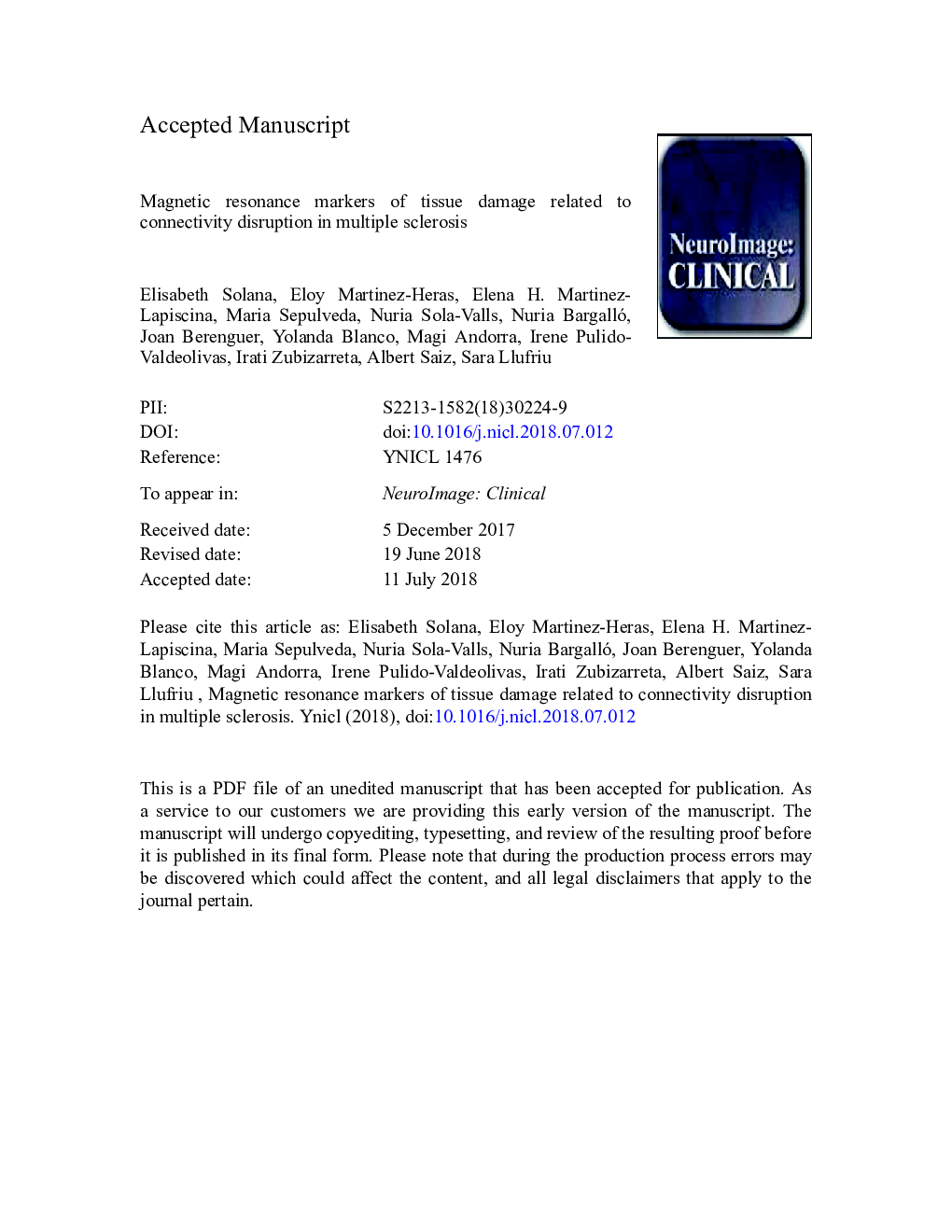| کد مقاله | کد نشریه | سال انتشار | مقاله انگلیسی | نسخه تمام متن |
|---|---|---|---|---|
| 8687518 | 1580947 | 2018 | 36 صفحه PDF | دانلود رایگان |
عنوان انگلیسی مقاله ISI
Magnetic resonance markers of tissue damage related to connectivity disruption in multiple sclerosis
ترجمه فارسی عنوان
نشانگرهای رزونانس مغناطیسی آسیب بافتی مربوط به اختلال اتصال در مولتیپل اسکلروزیس است
دانلود مقاله + سفارش ترجمه
دانلود مقاله ISI انگلیسی
رایگان برای ایرانیان
کلمات کلیدی
اتصال سازمانی، اسپکتروسکوپی رزونانس مغناطیسی، شبکه فدرال مولتیپل اسکلروزیس، شناخت،
موضوعات مرتبط
علوم زیستی و بیوفناوری
علم عصب شناسی
روانپزشکی بیولوژیکی
چکیده انگلیسی
Patients with multiple sclerosis (MS) display reduced structural connectivity among brain regions, but the pathogenic mechanisms underlying network disruption are still unknown. We aimed to investigate the association between the loss of diffusion-based structural connectivity, measured with graph theory metrics, and magnetic resonance (MR) markers of microstructural damage. Moreover, we evaluated the cognitive consequences of connectivity changes. We analysed the frontoparietal network in 102 MS participants and 25 healthy volunteers (HV). MR measures included radial diffusivity (RD), as marker of demyelination, and ratios of myo-inositol, N-acetylaspartate and glutamate+glutamine with creatine in white (WM) and grey matter as markers of astrogliosis, neuroaxonal integrity and glutamatergic neurotoxicity. Patients showed decreased global and local efficiency, and increased assortativity (pâ¯<â¯0.01) of the network, as well as increased RD and myo-inositol, and decreased N-acetylaspartate in WM compared with HV (pâ¯<â¯0.05). In patients, the age-adjusted OR of presenting abnormal global and local efficiency was increased for each increment of 0.01 points in RD and myo-inositol, while it was decreased for each increment of 0.01 points in N-acetylaspartate (the increase of N-acetylaspartate reduced the risk of having abnormal connectivity), all in WM. In a multiple logistic regression analysis, the OR of presenting abnormal global efficiency was 0.95 (95% confidence interval, CI: 0.91-0.99, pâ¯=â¯0.011) for each 0.01 increase in N-acetylaspartate, and the OR of presenting abnormal local efficiency was 1.39 (95% CI: 1.14-1.71, pâ¯=â¯0.001) for each 0.01 increase in RD. Patients with abnormal efficiency had worse performance in attention, working memory and processing speed (pâ¯<â¯0.05). In conclusion, patients with MS exhibit decreased structural network efficiency driven by diffuse microstructural impairment of the WM, probably related to demyelination, astroglial and neuroaxonal damage. The accumulation of neuroaxonal pathological burden seems to magnify the risk of global network collapse, while demyelination may contribute to the regional disorganization. These network modifications have negative consequences on cognition.
ناشر
Database: Elsevier - ScienceDirect (ساینس دایرکت)
Journal: NeuroImage: Clinical - Volume 20, 2018, Pages 161-168
Journal: NeuroImage: Clinical - Volume 20, 2018, Pages 161-168
نویسندگان
Elisabeth Solana, Eloy Martinez-Heras, Elena H. Martinez-Lapiscina, Maria Sepulveda, Nuria Sola-Valls, Nuria Bargalló, Joan Berenguer, Yolanda Blanco, Magi Andorra, Irene Pulido-Valdeolivas, Irati Zubizarreta, Albert Saiz, Sara Llufriu,
